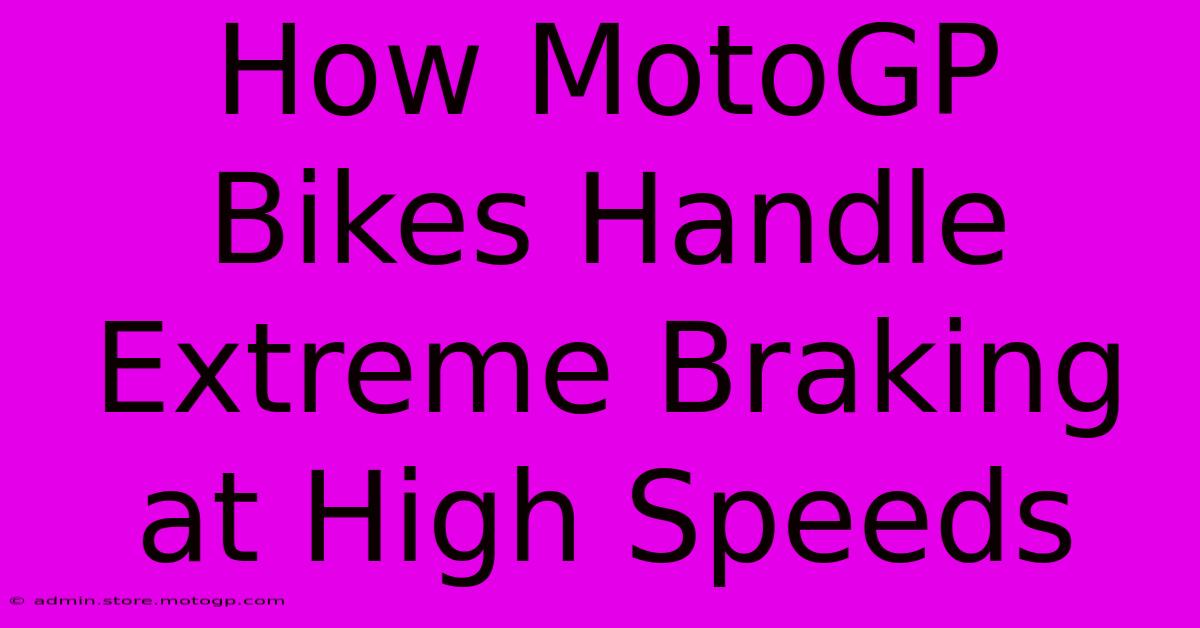How MotoGP Bikes Handle Extreme Braking At High Speeds

Table of Contents
How MotoGP Bikes Handle Extreme Braking at High Speeds
MotoGP racing pushes the boundaries of motorcycle technology and rider skill. One of the most breathtaking aspects of the sport is the incredible braking performance displayed by riders, especially when approaching corners at incredibly high speeds. This article delves into the intricate engineering and riding techniques that allow these machines to decelerate so dramatically without losing control.
The Physics of High-Speed Braking
Before we discuss the specifics of MotoGP bikes, let's understand the fundamental physics at play. High-speed braking generates immense forces. The primary force acting on the bike is inertia – the tendency of an object to resist changes in its motion. Overcoming this inertia requires substantial braking power, and that's where the sophisticated braking systems of MotoGP bikes come into play.
The Role of Inertia and Braking Force
The higher the speed, the greater the inertia, and consequently, the greater the braking force needed to slow down effectively. MotoGP bikes achieve this through a combination of powerful brakes, advanced tire technology, and expert rider input.
MotoGP Braking System Components: Engineering Excellence
MotoGP bikes boast incredibly powerful braking systems specifically designed to handle the extreme demands of high-speed braking. These systems incorporate several key components:
1. Carbon Fiber Brakes
Carbon fiber brake discs provide significantly improved braking power and heat dissipation compared to steel discs. This is crucial because high-speed braking generates immense heat, which can lead to brake fade (a reduction in braking effectiveness). Carbon fiber's ability to withstand and dissipate this heat ensures consistent braking performance even under extreme conditions.
2. Brembo Caliper Technology
Brembo calipers, renowned for their high performance, are typically used on MotoGP machines. These calipers use multiple pistons to apply pressure to the brake pads, providing immense stopping power. The precise engineering of these calipers ensures consistent and predictable braking feel.
3. Advanced Brake Pad Compounds
MotoGP teams meticulously select brake pad compounds based on track conditions and temperature. These compounds are designed to provide optimal friction and wear characteristics under extreme braking forces.
4. Sophisticated Brake Systems
The braking system itself is highly refined, often featuring adjustable levers to allow riders to fine-tune the braking feel and power according to track conditions and personal preference. This adjustability is critical for optimal control under varying circumstances.
Rider Technique: Mastering the Art of Braking
While the technology is crucial, the rider's skill is equally important in managing high-speed braking. MotoGP riders spend countless hours honing their techniques to achieve maximum deceleration while maintaining control. Key elements of their technique include:
1. Body Positioning
Riders use their body weight to help stabilize the bike during braking. This involves leaning forward and shifting their weight towards the front of the machine.
2. Trail Braking
Trail braking is a highly advanced technique where riders maintain some braking pressure while simultaneously beginning to turn into the corner. This allows them to use the bike's lean angle to aid in deceleration and maintain control.
3. Smooth and Progressive Braking
MotoGP riders rarely use abrupt braking. Instead, they apply the brakes smoothly and progressively, avoiding any sudden jerks or lockups that could lead to a crash.
4. Feedback and Adjustment
Throughout the braking process, riders constantly receive feedback from the bike and adjust their technique accordingly. This is a continuous feedback loop that allows for precise control and maximum performance.
Tire Technology and Grip
The tires themselves play a vital role in high-speed braking. MotoGP tires are specifically designed with advanced compounds and construction to provide maximum grip, even under extreme braking forces. The sophisticated tread patterns and rubber compounds help to manage heat build-up and maintain optimal contact with the track surface.
Conclusion: A Symphony of Engineering and Skill
The ability of MotoGP bikes to handle extreme braking at high speeds is a testament to the incredible advancements in motorcycle technology and the exceptional skill of the riders. It's a finely tuned balance between engineering excellence and human mastery, creating a spectacle of speed, precision, and breathtaking skill. The seamless integration of powerful braking systems, advanced tire technology, and refined rider techniques is what allows these machines to stop so dramatically and safely, making MotoGP racing the thrilling and demanding sport that it is.

Thank you for visiting our website wich cover about How MotoGP Bikes Handle Extreme Braking At High Speeds. We hope the information provided has been useful to you. Feel free to contact us if you have any questions or need further assistance. See you next time and dont miss to bookmark.
Featured Posts
-
Maximize Your Cota Experience Park In Lot R
Feb 18, 2025
-
Maximize Your Moto Gp Viewing Experience Understand The Points
Feb 18, 2025
-
Experience The Legacy Of Moto Gp With Tnt
Feb 18, 2025
-
The Science Behind The Moto Gp Desmosedicis Speed
Feb 18, 2025
-
The Best Motorcyclist Of All Time A Celebration Of Excellence
Feb 18, 2025
